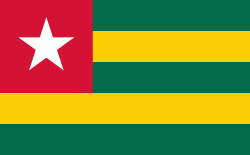Flag of Togo
The flag of Togo (drapeau du Togo) is the national flag, ensign, and naval jack of Togo. It has five equal horizontal bands of green (top and bottom) alternating with yellow. There is a white five-pointed star on a red square in the upper hoist-side corner. It uses the pan-African colors of Ethiopia, but the design resembles the flag of Liberia, which itself echoes the flag of the United States, making it part of both the pan-African and Stars and Stripes flag families.
The flag was designed by artist Paul Ahyi and approximates a golden rectangle closely. Ahyi was regarded as among the greatest of African artists of his generation. Born in Togo, Ahyi graduated from the École nationale supérieure des Beaux-Arts in Paris in 1959 and returned to Togo. He designed the flag of Togo while working on other contemporary works. The flag was adopted on 28 April 1960, and is still in use. During France's rule over Togo from 1957 to 1958, the flag of French Togo was used. After Togo's independence, the first Flag of Togo was used from 1958 to 1960.
The flag was designed by artist Paul Ahyi and approximates a golden rectangle closely. Ahyi was regarded as among the greatest of African artists of his generation. Born in Togo, Ahyi graduated from the École nationale supérieure des Beaux-Arts in Paris in 1959 and returned to Togo. He designed the flag of Togo while working on other contemporary works. The flag was adopted on 28 April 1960, and is still in use. During France's rule over Togo from 1957 to 1958, the flag of French Togo was used. After Togo's independence, the first Flag of Togo was used from 1958 to 1960.
National flag
Country - Togo
Warning: getimagesize(/Image/Map/MP2363686.gif): failed to open stream: No such file or directory in /home/mapnlee7/public_html/MAPNALL/article.php on line 532
 |
 |
Various people groups settled the boundaries of present day Togo between the 11th to 16th centuries. Between the 16th and 18th centuries, the coastal region served primarily as a European slave trading outpost, earning Togo and the surrounding region the name "The Slave Coast". In 1884, Germany declared a region including a protectorate called Togoland. After World War I, rule over Togo was transferred to France. Togo gained its independence from France in 1960. In 1967, Gnassingbé Eyadéma led a successful military coup d'état, after which he became president of an anti-communist, single-party state. In 1993, Eyadéma faced multiparty elections marred by irregularities, and won the presidency three times. At the time of his death, Eyadéma was the "longest-serving leader in modern African history", having been president for 38 years. In 2005, his son Faure Gnassingbé was elected president.
